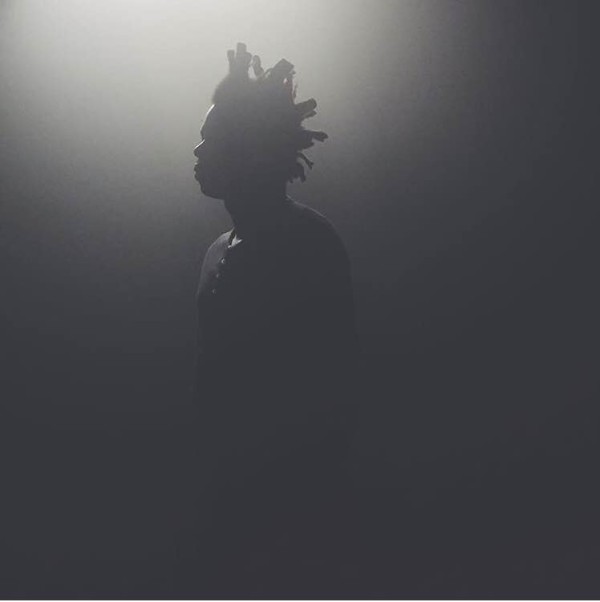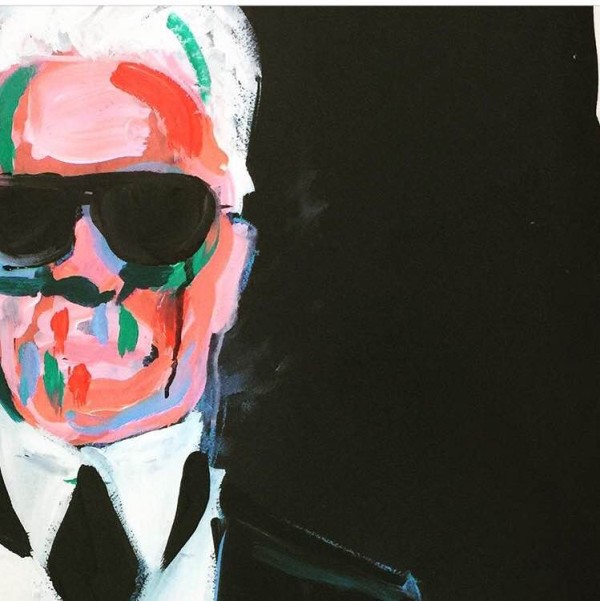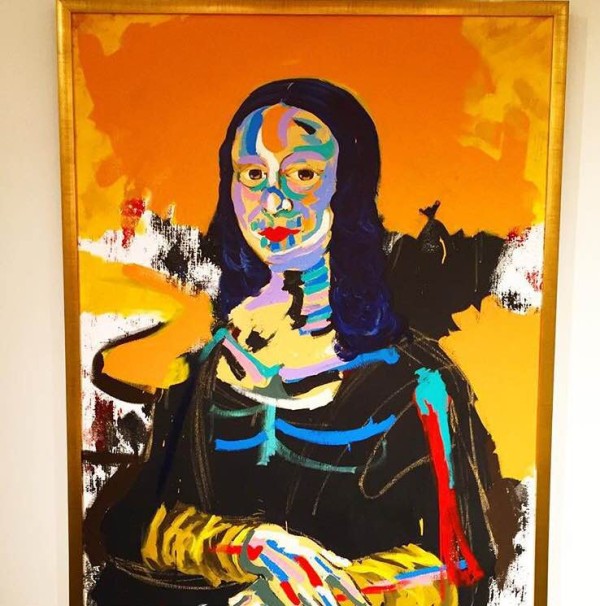In order to get to Bradley Theodore’s Sunday spot, you have to walk passed a set of bouncers checking for Id’s and go up the rugged stairs, into another entrance, on another floor, and passed the small entry way into a rooftop scenery. Hotel Chantelle, NYC’s number one brunch spot, is an exclusive room that is more dense than many Manhattan rooftops; maintaining a side room with a ceiling, a bathroom, several tables carefully placed, and a band interpreting early 20th century entertainment. There are black and white hexagon shaped tiles all the way up to the bar filled with people from all walks of life. Each seat holds a new group of conversation: bouncing off of the graffiti inspired art, trembling trombones, and waiters dressed in mustard yellow and indigo. The very people sitting in the aisles are the same people who are fans of Theodore’s murals and street art; commissioned pieces; outlines, and sketches. Outside, his skeletal mural of fashion giant, Nick Wooster, looks childlike, elegant, and removed from any social mask. The connection between Chantelle’s aesthetic and clientele is the kind of connection most of us have trouble finding throughout our lives.
Standing behind one of the bar’s tables in the middle of the crowd, Theodore chats with one of the restaurant’s higher ups. He smiles, takes off his shades, and calls my photographer and I over. In this place everyone knows Mr. Theodore by Bradley, and for good reason (the week before he was moon-walking through the rooftop’s aisles.)
Here, photographers, waiters, promoters, and owners acknowledge him as a celebrity and so, subsequently, a table is quickly arranged for us. After suggesting food from the menu, Theodore quickly begins to classify the culture for our interview, a day in a life rather than a Q&A; and the mess of his spontaneous, but planned up rise in the vast world of art – an industry that usually shuns most African Americans. Few artists succeed in the way Theodore has, who takes trips around the world to showcase his work. He has stories to tell of almost every country worth visiting – who he saw, and how he felt. The artist will reflect those records on gallery walls in France in just a few months. As one can tell by the speed at which Theodore works, the art is more than just a way of making a living; its a survival in itself.
Each time we meet for conversation, a fan or employee breaks us off again, however, Theodore remains warm and inviting. He is so seasoned as a communicator that strangers talk to him in the street, waiters and hostesses in restaurants want to do things for him.
Theodore and his family, coming from the Caribbean, says that some of his first memories in America are traumatic ones in the ghettos of Miami. His art is made by a soul, whose determined to support his family, and make a name for himself in the city he fell in love with at 17. When Theodore explains the true sign of transcendence as the ability to communicate with any and everyone – I am tempted for a moment to ask if he is putting on a front for me, but I don’t want to blur or complicate the image of him.
“NYC is the greatest drug in the world, once you go there, you can’t go back.”
Eventually, there came a moment in time when two FIT graduates entered the conversation, and, by the times end, both Theodore and I were on each side preaching the concept of fighting on for the dreams you believe in. If that wasn’t enough – Theodore’s magnetism lured in another loyal fan – this time an advertisement graphic designer torn by the pulls of doing what drew in the money and what ideas he actually believed in. This is when Theodore said: “Look, do this… you work for a year straight. You sacrifice. You save, you build, You lose friends if you have to, but in the end, you work and save. And when that year is done, you invest in what you believe in.” This is when I realized how wise this artist was.
As a 24 year old who grew up in the middle of America’s anime influx with shows like Dragon Ball Z, the concept of preserving oneself, in order to build oneself up was a thought and process I held an affinity for. As time went on, in that small corner on a NYC rooftop, surrounded by four mesmerized fans, where no one knew each other for more than 20 minutes, the only common denominator here was the need for more. A terrifying hunger for livelier lives drawn by the hand of our creative side; and a few glasses of champagne. If I’ve learned anything in life, its that what brings people together most, is when they have something in common to complain about. This table, however, was not centered on the complaint, but rather the solution, and Theodore was, and continues to be, the center of that conversation – especially for NYC artists in the downtown LES area.
If you walk down Ludlow, a hot spot for NYC night life, you can see Theodore’s work everywhere. He has been compared to Jean-Michel Basquiat as a black artist and for his unmistakable style maintained on the district’s walls. As proven, Theodore’s work not only draws attention, but also revenue.
“One of my friends owned a restaurant, and was like, you know what, just go ahead. Paint the walls. Next thing I know, about a week after I complete the work – he calls me and says – yo, people actually stop and take pictures of this thing. I was like, ‘I know.’ He had no idea.”
 Theodore’s story is exactly that – a style, stripped, hallowed, evaluated, terminated of materialism, and shining through only essence. And yet, Bradley in no way hides the fact that he has seen traumatic experiences in the ghettos of America and that it wasn’t until that year of starving and saving that he got to travel the world and broaden his horizons. Overall, The paradox of Theodore, and his art, is mostly in preserving street genetics with that of his adopted aristocratic lifestyle.
Theodore’s story is exactly that – a style, stripped, hallowed, evaluated, terminated of materialism, and shining through only essence. And yet, Bradley in no way hides the fact that he has seen traumatic experiences in the ghettos of America and that it wasn’t until that year of starving and saving that he got to travel the world and broaden his horizons. Overall, The paradox of Theodore, and his art, is mostly in preserving street genetics with that of his adopted aristocratic lifestyle.
A metaphor that came from Theodore’s wisdom-filled moments came in an analogy when speaking on America’s tendency to exclude the immigrant, but bank off their culture, mass produce their innovations, and exploit their creations in their inability to do so because of limited resources.
“Its like this,” he went “if a man on an island has coconuts growing in his backyard, I may go to him and say, let me buy some coconuts off of you – you’re not doing anything with it. Then, if that works, I’ll come back and buy more, and, eventually, if he does nothing, I’ll take the land… That’s what America has done with the culture of the immigrant in this country.”
I could not help but associate this analogy with that of cultural appropriation, where one’s culture – style of dress, language, dance, and art can be taken in the blink of an eye and sold for profit in elite markets, whereas those responsible for the culture cannot, due in part to limited resources and limited education. If those people lacking resources and education knew the worth of his land (style of dress, language, dance, and art) and the capabilities of its potential, then he too, would be a millionaire. However, he does not. And this is the point that I believe Bradley was making. It was not until he traveled the world, exposed himself to new people, lands, and cultures, that he realized how his world and thinking had been so limited.
There was an abundance of tequila shots served as the night proceeded, and more stories to go around.
The story for his Karl Lagerfeld painting goes: he was in Paris when he approached the entrance to an exclusive party. After being denied at the door, profiled as a black man, and threatened to be forced out – he made some phone calls, where he soon found himself in the cluttered party where he saw Lagerfeld, bopping his body and his head, at his age, to the contemporary music in a corner. From that day on, though it did not happen until months later, he knew he would paint the fashion icon. Interesting enough, I heard Theodore tell the story on two occasions to two different people, the same way, having the same effects. I was quickly realizing the kind of guy Theodore was – an entertainer always. Surrounded by aristocrats on a NYC rooftop, where a New Jersey resident, like myself, could only dream of being accepted, let alone feel welcomed – was a peak into the world of a painter on the cusp of international recognition. The following day after our time together, Theodore would work on a very important corporation’s commission – Moe’t.
His paintings of fashion icons, remind us that beneath every $5000 suit is a man with bones and insecurities, like anyone else; and that if you looked long enough, you could see the same bones of greatness in oneself.
Bradley’s work is the culmination of a generation’s infatuation with celebrities and its dying need to maintain it’s individualism. His work tethers that middle ground of comfort and misery, new and old, comfort and distress; measuring the balance of a world unknown to immigrants and minorities, while maintaining its identity in sharing its culture.
Behind the hair, the glasses, and the pants with the paint still on them, was another human from a disturbed past, suppressed into the image he gives the world today. The most beautiful thing in the process is that Theodore may just as well be one of the greatest acting painters I have met; however, whether right or wrong about that presumption, one thing is clear – he gives all of himself in his paintings, and when you walk away from a street corner with a Bradley Theodore’s, you just walked away with a part of the man they call the next Basquiat, the guy Chantelle’s calls Brad, while others, whom I’ve met, call idol.
– Hurtjohn
Photo Credit:






